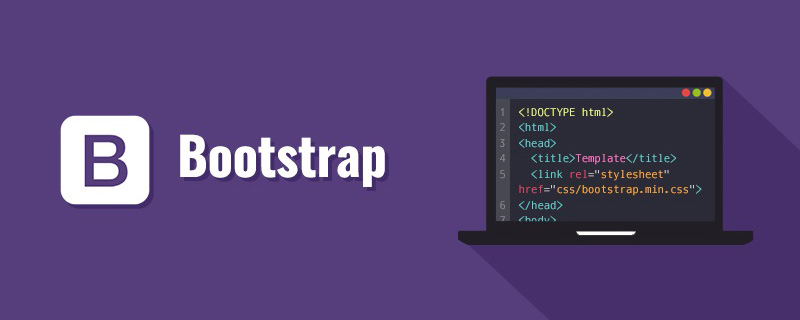 Web Front-end
Web Front-end Bootstrap Tutorial
Bootstrap Tutorial A brief discussion on how to directly enter table row data in Bootstrap (1)
A brief discussion on how to directly enter table row data in Bootstrap (1)This article will introduce to you how to use dataTable to directly enter table row data in the Bootstrap development framework. It has certain reference value. Friends in need can refer to it. I hope it will be helpful to everyone.

When developing Winform, we can often use table controls to directly enter data. However, we rarely see it on the Web. In fact, we can also use the dataTable object to directly enter data. Entering table row data can improve the convenience of data entry, especially when it comes to detailed data for some simple businesses. It seems to be more convenient and taller than pop-up window entry. This article mainly introduces the use of dataTable to directly enter table row data in the Bootstrap development framework. [Related recommendations: "bootstrap Tutorial"]
1. Direct data entry based on tables and Winform interface review
Directly start the Web interface Before entering the table row data, let's first take a look at the processing of the Winform interface. For example, in process management, I use the following interface for data processing of the reimbursement business table with master-slave details.

This kind of detailed form can be added and edited directly on the grid control Griview.
As for the Web interface, if we want to maintain a layout similar to this, we can also use dataTable to directly enter table row data.

When the above interface processes detailed data, you can directly use the new record, enter the data directly in the input box, and then save it. After saving, the data becomes read-only. , if you need to modify it, you can also click the edit button to modify it.
These detailed data only exist in JS objects and have not been saved to the backend database. We can obtain all the added data for submission during the final save (as shown in the OK button on the interface above). That’s it.
After submitting these data, we can use the Bootstrap Table plug-in to display the data in the viewing interface.

2. Implementation of using dataTable to directly enter table row data on the Web
The above interface shows how to use dataTable on the Web dataTable directly inputs table row data and data display. Here we begin to introduce their interface and implementation code.
The interface part mainly deals with this detail.

The HTML code of the interface view is as follows.
<div class="portlet light portlet-fit ">
<div class="portlet-title">
<div class="caption">
<i class="icon-settings font-red"></i>
<span class="caption-subject font-red sbold uppercase">明细清单</span>
</div>
</div>
<div class="portlet-body">
<div class="table-toolbar">
<div class="row">
<div class="col-md-6">
<div class="btn-group">
<button id="detail_editable_1_new" class="btn green">
新增记录
<i class="fa fa-plus"></i>
</button>
</div>
</div>
</div>
</div>
<table class="table table-striped table-hover table-bordered" id="detail_editable_1">
<thead>
<tr>
<th>序号</th>
<th> 费用类型 </th>
<th> 发生时间 </th>
<th> 费用金额(元) </th>
<th> 费用说明 </th>
<th> 编辑 </th>
<th> 删除 </th>
</tr>
</thead>
<tbody>
@*<tr>
<td> 1 </td>
<td> 交通费 </td>
<td> 2018-10-01 </td>
<td> 2000 </td>
<td> 备注信息 </td>
<td>
<a class="edit" href="javascript:;"> 编辑 </a>
</td>
<td>
<a class="delete" href="javascript:;"> 删除 </a>
</td>
</tr>*@
</tbody>
</table>
</div>
</div>The main one is the tag with ID detail_editable_1. This is the table that carries detailed information. We can define the header information we need, and the content of the input box can be dynamically added through the object of the dataTable plug-in. .
//定义dataTable对象
var table = $('#detail_editable_1');
var oTable = table.dataTable({
"lengthMenu": [
[5, 15, 20, -1],
[5, 15, 20, "All"] // 改变每页的行数
],
// 使用汉化
"language": {
url: '//cdn.datatables.net/plug-ins/3cfcc339e89/i18n/Chinese.json'
},
//初始化
"pageLength": 5,
"columnDefs": [{ // 设置默认列设置
'orderable': true,
'targets': [0]
}, {
"searchable": true,
"targets": [0]
}],
"order": [
[0, "asc"]
] // 将第一列设置为asc的默认排序
});Editing row records means dynamically adding some Input controls so that users can enter data, as shown in the following code.
//编辑行
function editRow(oTable, nRow) {
var aData = oTable.fnGetData(nRow);
var jqTds = $('>td', nRow);
jqTds[0].innerHTML = '<input type="text" class="form-control input-small" value="' + aData[0] + '" readonly>';
jqTds[1].innerHTML = '<input type="text" class="form-control input-small" value="' + aData[1] + '">';
jqTds[2].innerHTML = '<input type="date" class="form-control input-small" value="' + aData[2] + '">';
jqTds[3].innerHTML = '<input type="number" class="form-control input-small" value="' + aData[3] + '">';
jqTds[4].innerHTML = '<input type="text" class="form-control input-small" value="' + aData[4] + '">';
jqTds[5].innerHTML = '<a class="edit" href="">保存</a>';
jqTds[6].innerHTML = '<a class="cancel" href="">取消</a>';
}After saving the data, update the record into the corresponding TD object, as shown below.
//费用类型 发生时间 费用金额 费用说明
var objList = [];
//保存行数据,切换到普通模式
function saveRow(oTable, nRow) {
var jqInputs = $('input', nRow);
//更新行中每个input的值
oTable.fnUpdate(jqInputs[0].value, nRow, 0, false);
oTable.fnUpdate(jqInputs[1].value, nRow, 1, false);
oTable.fnUpdate(jqInputs[2].value, nRow, 2, false);
oTable.fnUpdate(jqInputs[3].value, nRow, 3, false);
oTable.fnUpdate(jqInputs[4].value, nRow, 4, false);
oTable.fnUpdate('<a class="edit" href="">编辑</a>', nRow, 5, false);
oTable.fnUpdate('<a class="delete" href="">删除</a>', nRow, 6, false);
oTable.fnDraw();
}Several action buttons on the interface, such as add, edit, save, delete and other button processing events are as follows.
var addRow = 1;
$('#detail_editable_1_new').click(function (e) {
e.preventDefault();
if (nNew && nEditing) {
if (confirm("前面记录没有保存,您是否需要保存?")) {
saveRow(oTable, nEditing);
//$(nEditing).find("td:first").html("未保存");
nEditing = null;
nNew = false;
} else {
oTable.fnDeleteRow(nEditing); // cancel
nEditing = null;
nNew = false;
return;
}
}
//添加一条新的记录
var aiNew = oTable.fnAddData([addRow++, '', '', '', '', '', '']);
var nRow = oTable.fnGetNodes(aiNew[0]);
editRow(oTable, nRow);
nEditing = nRow;
nNew = true;
});
//删除操作
table.on('click', '.delete', function (e) {
e.preventDefault();
if (confirm("您确认要删除该行记录吗?") == false) {
return;
}
//获取上一级tr行的数据
var nRow = $(this).parents('tr')[0];
var aData = oTable.fnGetData(nRow);
var found = false;
$.each(objList, function (i, item) {
if (item["seq"] == aData[0]) {
found = true;
objList.splice(i, 1);
}
});
oTable.fnDeleteRow(nRow);
});
//取消操作
table.on('click', '.cancel', function (e) {
e.preventDefault();
if (nNew) {
oTable.fnDeleteRow(nEditing);
nEditing = null;
nNew = false;
} else {
restoreRow(oTable, nEditing);
nEditing = null;
}
});
//编辑操作
table.on('click', '.edit', function (e) {
e.preventDefault();
nNew = false;
/*获取所击连接的行对象*/
var nRow = $(this).parents('tr')[0];
if (nEditing !== null && nEditing != nRow) {
/* 当前正在编辑 - 但不是此行 - 在继续编辑模式之前恢复旧版 */
restoreRow(oTable, nEditing);
editRow(oTable, nRow);
nEditing = nRow;
} else if (nEditing == nRow && this.innerHTML == "保存") {
/* 编辑该行,并准备保存记录 */
saveRow(oTable, nEditing);
nEditing = null;
} else {
/* No edit in progress - let's start one */
editRow(oTable, nRow);
nEditing = nRow;
}
});
}In the last step, when submitting data, we traverse the entire table, obtain the data of each row, and put them into the JSON object list, and then submit it to the background for input. The following is the list of acquisition Data JS code
//获取表格的数据,并返回对象列表
function GetData() {
var list = [];
var trs = table.fnGetNodes();
for (var i = 0; i < trs.length; i++) {
var data = table.fnGetData(trs[i]);//获取指定行的数据
var obj = {};
//obj["seq"] = data[0];//序号
obj["FeeType"] = data[1];
obj["OccurTime"] = data[2];
obj["FeeAmount"] = data[3];
obj["FeeDescription"] = data[4];
list.push(obj);
}
return list;
};After obtaining the detailed data of the form, we determine how to submit it to the MVC backend interface for processing. The following is the JS code for submitting detailed data to the MVC backend in the business.

The C# processing logic code of the background MVC controller is as follows.
/// <summary>
/// 保存申请单主从表数据
/// </summary>
/// <returns></returns>
[HttpPost]
public ActionResult SaveApply(JObject param)
{
dynamic obj = param;
if (obj != null)
{
var result = new CommonResult();
if (obj.info != null)
{
//获取主信息
var info = (JObject.FromObject(obj.info)).ToObject<ReimbursementInfo>();
//转换为明细信息
List<ReimbursementDetailInfo> details = null;
if (obj.details != null)
{
details = (JArray.FromObject(obj.details)).ToObject<List<ReimbursementDetailInfo>>();
}
if (info != null)
{
//修改部分信息
OnBeforeInsert(info);
bool succeed = BLLFactory<Reimbursement>.Instance.Insert(info);
if (succeed)
{
if (details != null)
{
foreach (var detailInfo in details)
{
//设置关键信息
detailInfo.Apply_ID = info.Apply_ID;
detailInfo.Header_ID = info.ID;
BLLFactory<ReimbursementDetail>.Instance.InsertUpdate(detailInfo, detailInfo.ID);
}
}
result.Success = succeed;
}
}
}
return ToJsonContent(result);
}
else
{
throw new MyApiException("传递参数错误");
}
}For the submitted data, the object information is converted using JObject, and for the detailed list, JArray.FromObject is used for conversion. The other part is how to save the interface of the main table and the detailed table.
The above processing logic and code are to process the front-end acquisition, submission processing, and back-end interface processing of the detailed table. The entire process is mainly used to introduce the use of dataTable to directly enter table row data in the Bootstrap development framework.
For more programming-related knowledge, please visit: Programming Video! !
The above is the detailed content of A brief discussion on how to directly enter table row data in Bootstrap (1). For more information, please follow other related articles on the PHP Chinese website!
 10款好看又实用的Bootstrap后台管理系统模板(快来下载)Aug 06, 2021 pm 01:55 PM
10款好看又实用的Bootstrap后台管理系统模板(快来下载)Aug 06, 2021 pm 01:55 PM一个好的网站,不能只看外表,网站后台同样很重要。本篇文章给大家分享10款好看又实用的Bootstrap后台管理系统模板,可以帮助大家快速建立强大有美观的网站后台,欢迎下载使用!如果想要获取更多后端模板,请关注php中文网后端模板栏目!
 bootstrap与jquery是什么关系Aug 01, 2022 pm 06:02 PM
bootstrap与jquery是什么关系Aug 01, 2022 pm 06:02 PMbootstrap与jquery的关系是:bootstrap是基于jquery结合了其他技术的前端框架。bootstrap用于快速开发Web应用程序和网站,jquery是一个兼容多浏览器的javascript库,bootstrap是基于HTML、CSS、JAVASCRIPT的。
 7款实用响应式Bootstrap电商源码模板(快来下载)Aug 31, 2021 pm 02:13 PM
7款实用响应式Bootstrap电商源码模板(快来下载)Aug 31, 2021 pm 02:13 PM好看又实用的Bootstrap电商源码模板可以提高建站效率,下面本文给大家分享7款实用响应式Bootstrap电商源码,均可免费下载,欢迎大家使用!更多电商源码模板,请关注php中文网电商源码栏目!
 8款Bootstrap企业公司网站模板(源码免费下载)Aug 24, 2021 pm 04:35 PM
8款Bootstrap企业公司网站模板(源码免费下载)Aug 24, 2021 pm 04:35 PM好看又实用的企业公司网站模板可以提高您的建站效率,下面PHP中文网为大家分享8款Bootstrap企业公司网站模板,均可免费下载,欢迎大家使用!更多企业站源码模板,请关注php中文网企业站源码栏目!
 bootstrap中sm是什么意思May 06, 2022 pm 06:35 PM
bootstrap中sm是什么意思May 06, 2022 pm 06:35 PM在bootstrap中,sm是“小”的意思,是small的缩写;sm常用于表示栅格类“.col-sm-*”,是小屏幕设备类的意思,表示显示大小大于等于768px并且小于992px的屏幕设备,类似平板设备。
 bootstrap默认字体大小是多少Aug 22, 2022 pm 04:34 PM
bootstrap默认字体大小是多少Aug 22, 2022 pm 04:34 PMbootstrap默认字体大小是“14px”;Bootstrap是一个基于HTML、CSS、JavaScript的开源框架,用于快速构建基于PC端和移动端设备的响应式web页面,并且默认的行高为“20px”,p元素行高为“10px”。
 bootstrap modal 如何关闭Dec 07, 2020 am 09:41 AM
bootstrap modal 如何关闭Dec 07, 2020 am 09:41 AMbootstrap modal关闭的方法:1、连接好bootstrap的插件;2、给按钮绑定模态框事件;3、通过“ $('#myModal').modal('hide');”方法手动关闭模态框即可。
 bootstrap是免费的吗Jun 21, 2022 pm 05:31 PM
bootstrap是免费的吗Jun 21, 2022 pm 05:31 PMbootstrap是免费的;bootstrap是美国Twitter公司的设计师“Mark Otto”和“Jacob Thornton”合作基于HTML、CSS、JavaScript 开发的简洁、直观、强悍的前端开发框架,开发完成后在2011年8月就在GitHub上发布了,并且开源免费。


Hot AI Tools

Undresser.AI Undress
AI-powered app for creating realistic nude photos

AI Clothes Remover
Online AI tool for removing clothes from photos.

Undress AI Tool
Undress images for free

Clothoff.io
AI clothes remover

AI Hentai Generator
Generate AI Hentai for free.

Hot Article

Hot Tools

MantisBT
Mantis is an easy-to-deploy web-based defect tracking tool designed to aid in product defect tracking. It requires PHP, MySQL and a web server. Check out our demo and hosting services.

Atom editor mac version download
The most popular open source editor

Dreamweaver Mac version
Visual web development tools

Notepad++7.3.1
Easy-to-use and free code editor

SublimeText3 English version
Recommended: Win version, supports code prompts!






